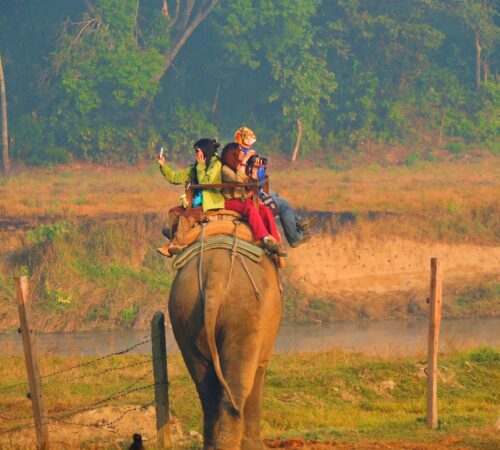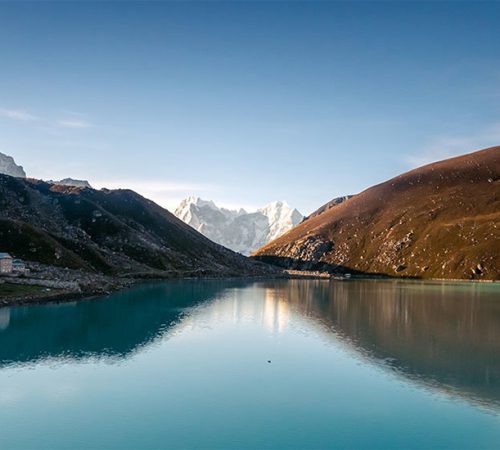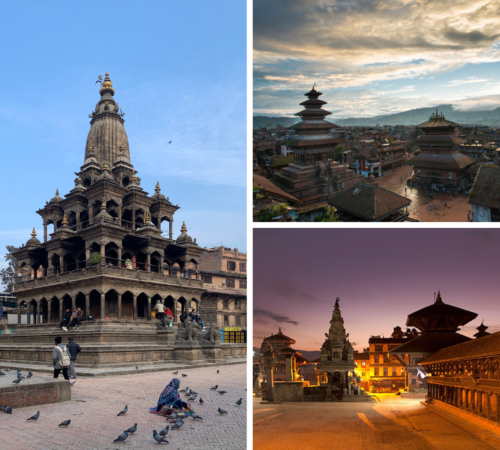Trip Facts
-
Duration
19 Days
-
Trip Start and End
Kathmandu/ Kathmandu
-
Difficulty Level
Light
-
Trip Area
Everest Region
-
Maximum Altitude
6165m/20,226.38ft - Island Peak (Imja Tse)
-
Best Season
Spring & Autumn
-
Meals
Full Board
-
Accommodation
Teahouses/Lodges
-
Transportation
Flight/Jeep/Bus
Highlights
- Adventurous & Scenic flight to Lukla
- The Sherpa capital Namche Bazaar
- Largest & beautiful Tengboche Monastery
- Climbing/Expediting Island Peak
- Stunning views of Nuptse, Baruntse, Makalu, Ama Dablam, Lhotse, etc.
Trip Overview
Island Peak, also known as Imja Tse, is a majestic mountain located in the Khumbu region of the Himalayas, towering at 6,165 meters (20,226 feet) above sea level. Its distinctive pyramid shape and challenging ascent make it a popular choice for climbers seeking an exhilarating adventure in the heart of the Nepalese Himalayas. The climb to Island Peak offers a unique blend of trekking and mountaineering, allowing adventurers to immerse themselves in the breathtaking landscapes of the Everest region while pushing their physical and mental limits.
The journey to Island Peak typically begins with a trek through the picturesque villages and rugged terrain of the Everest region, providing climbers with a glimpse into the rich Sherpa culture and stunning natural beauty of the Himalayas. As the trek progresses, adventurers gradually acclimatize to the high altitude, preparing their bodies for the demanding ascent ahead. Along the way, trekkers traverse through lush rhododendron forests, remote valleys, and glacial moraines, soaking in panoramic views of towering peaks such as Everest, Lhotse, and Nuptse.
Reaching the summit of Island Peak is a momentous achievement that rewards climbers with unparalleled vistas of the surrounding Himalayan giants and a profound sense of accomplishment. The final push to the summit involves navigating steep snow and ice slopes, requiring technical climbing skills and a steady nerve. However, the breathtaking sunrise views from the summit, with the vast expanse of the Everest region stretching out below, make every moment of the challenging ascent worthwhile. Island Peak climbing is not just a physical challenge; it's an opportunity to connect with nature, test one's limits, and forge unforgettable memories in one of the world's most awe-inspiring landscapes.
Peak Profile of Api Himal
Latitude: 27º 55' 14"
Longitude: 86º 56' 16"
1st ascent in 1956 AD by
Hansrudolf Von Gunten, and
2 unknown Sherpas,
Detail Itinerary
+ Show MoreOur representative greets you at the Tribhuvan International Airport upon your Kathmandu arrival. Then, transfer to the hotel upon completing all the formalities. Freshen up and spend your time relaxing in your hotel. Later, visit the nearby places if you wish to. Return to hotel for overnight.
Cost Includes
- All land transportation and domestic flights as required for the trip itinerary
- Pick-ups and Drop-offs in a private vehicle at the airport (Arrival & Departure)
- Hotel Accommodations (Bed & Breakfast) in the city
- 3-course meal (Breakfast, Lunch, & Dinner) during the entire trek
- Accommodations in teahouses/guesthouses/lodges and tented camps as per the nature of the trek
- Necessary trek permits, national parks, and restricted areas entrance fees
- Tent camps equipment, kitchen equipment for camping treks
- First-aid Medical Kits
- Experienced and government license holder English-speaking trekking guides
- Porters (2 trekkers: 1 porter), supporting crews, cooks, & asst. cooks (depending on the nature of the trek)
- Allowances for crew staff including insurance on medical grounds
- All government taxes, official charges
- Emergency rescue (if needed)
Cost Excludes
- International Airfare
- Nepal Entry Visa Fees
- Airport taxes at the time of departure
- Personal Expenses
- Additional charges in the tea/guesthouses (Wi-Fi, electricity charge, hot shower, laundry, boiled water)
- Meals (Lunch & Dinner) in Kathmandu
- Extra night’s stay accommodation and meals in Kathmandu
- All kinds of Alcoholic & Non-alcoholic Beverages, Mineral Water
- Personal Trekking Gears
- Emergency Rescue cost & Travel Insurance cost
- Tips to the supporting crew members (guides, porters, drivers) after the trip completion
- All expenses need to be bear themselves in case of political instability & unforeseen events
Guidelines/Information
Accommodation
Accommodations in the Himalayas are mostly teahouses/guesthouses/lodges. In the city, the hotel is the accommodation. Generally, the teahouses are simple with basic facilities but comfortable to stay in. For the use of Wi-Fi, charging electronic devices, hot water buckets, laundry, and boiled water, trekkers must pay an additional charge. For Island peak climbing, accommodation is tented camps at Island Peak Base Camp and High Camp.
Meals
In the city, only breakfast is provided. During the entire trek in the Everest region, a full 3-course meal (breakfast, lunch, and dinner) is provided from the teahouses. The meals are basic but organic and healthy suitable for the health of the trekkers. The prime dish is Nepali Dal-Bhat served with vegetable curry and pickles. Besides Dal-Bhat, noodles, soups, Sherpa stew, hot drinks, roti, and fresh curries are served. There is no variety of meals at the teahouses but one can enjoy the continental dishes at Namche at your personal expense.
For peak climbing, meals are prepared by a professional cook who accompanied us during the trek. All necessary kitchen equipment is carried with us. The meals prepared during the treks are healthy and hygienic. It provides great energy for trekkers/climbers.
Drinking water
Drinking water keeps the body hydrated which is essential during peak climbing. In the Himalayas, water is pure and fresh. One can directly drink water from the natural stream from the Himalayas. Or one can fill up the boiled water at the teahouses paying an additional charge. Water-purifying solution kits are a must. So, always carry for safe water treatment and to stay safe & healthy. Remember to carry a water bottle to minimize the use of plastic bottles.
Communication
Everest Link’s Wi-Fi card is the internet provider in the entire Everest region. The internet connectivity is stable and easily accessible in the lower regions of Everest. The mobile network is also stable in the lower region. But, in the higher regions both mobile network and internet connectivity is unstable, and sometimes no connection at all. One can also purchase a local Sim to use the phone and mobile data internet in the lower regions.
Required Permits
Khumbu permit costs: NPR 2000 (Foreigners), NPR 1000 (SAARC)
SNP permit costs: NPR 3000 (Foreigners), NPR 1500 (SAARC)
Island Peak permit cost as per different seasons:
- Spring (March-May): USD 250 per person
- Autumn (September-November): USD 125 per person
- Summer (June-August) & Winter (December-February): USD 70/person
Garbage Deposit Fee costs USD 500
Following documents are required for Island Peak Permit:
- Passport-sized photos
- Passport Photocopy with 6 months validity
- Nepali currency (NPR)
- Application forms
- Travel Insurance
Travel Insurance
Travel Insurance is required while trekking and peak climbing in Nepal. Travel Insurance makes your journey stress-free. It acts as a safety tool that prevents unforeseen and unwanted events during the travel journey. One must get travel insurance from a trusted insurance company. It must cover all emergencies, flight cancelations, loss/theft of luggage, altitude over 3000m, evacuations, and medical difficulties.
Safety and our guides
The client’s safety is our topmost priority. So, when it comes to safety one can 100% trust us. Our guides are certified and have years of experience in this field. They are aware of the technical difficulties, altitude sickness, and health of the trekkers in the Himalayas. Thus, they are fully prepared and always carry necessary medical kits, safety tools, and are experts in safety performances. From the beginning to the end of the trek, the client’s safety is taken into consideration and kept as a high priority. Therefore, all the program itineraries are carefully planned and scheduled with proper acclimatization and rest days to prevent altitude sickness and adapt to the higher altitude. Before climbing Island peak, training is provided on the appropriate use of equipment and gear. We are 24/7 available at your service. Hence, feel free to ask queries and share your thoughts.
Best time for Island Peak Climbing
All seasons have their beauty. But, when it comes to Island Peak Climbing, Spring and Autumn seasons are termed best. These two seasons are the best time to climb as the weather is clear, the days are bright, and trekking trails are easy to walk. Winter and Rainy seasons are riskier due to muddy, slippery, and snowy trails. The weather is also uncertain and the chances of the temperature rising are high making it cold for the trekkers. It is advisable to properly plan before climbing the peak in the winter seasons. The permit cost for different seasons are given below:
- Spring (March-May): USD 250 per person
- Autumn (September-November): USD 125 per person
- Summer (June-August) & Winter (December-February): USD 70 per person
Island Peak Climbing Difficulty
Island Peak is a Group B classified peak by Nepal Mountaineering Association (NMA). Island Peak Climbing is extremely challenging due to its long duration, elevation, and trail structure. The trek trails include several steeps ascends, and descends, rugged trails, and high elevations. Climbers should experience mountaineering at high altitudes and train in climbing, knowledge on using gears and equipment properly before climbing the actual peak. The trekking experience at the high altitude is a plus point. Besides this, climbers must be physically and mentally fit before the start of the peak climbing journey. Climbers should take part in physical training, exercises, short day hikes, cardiovascular exercises, and eat healthy diets. Take essential health tests and keep yourself motivated before the journey. Here in Nepal, our assistance is always there throughout the peak climbing journey.
Altitude Sickness and Acclimatization
Altitude sickness is common at an altitude above 3000m. Here in Nepal, during peak climbing, altitude sickness chances are high. The high elevation, the weather, and the temperature play a key role. Thus, to prevent altitude sickness acclimatization is quintessential. Thus, the acclimatization rest days are carefully scheduled at Namche and High Camp to adapt to the surroundings. All age groups and even healthy people can suffer from altitude sickness. But, no need to panic as its symptoms and precautionary advice is given below:
Altitude Sickness Symptoms
The symptoms of altitude sickness are primary at the initial stage and get extreme if primary symptoms are not taken into consideration.
Primary symptoms: Headache, vomiting, breathlessness, loss of appetite & sleep, tiredness, vertigo
Extreme symptoms: primary symptoms along with delusions & unconsciousness
Precautionary Advice
- Inform the guide immediately
- Stretch the body and do warm up before the start of the trekking journey
- Keep yourself hydrated by drinking water at regular intervals
- Urinate frequently throughout the journey
- Keep it slow and steady
- Take proper rest and sleep
- Avoid taking salty and unhygienic foods
- Avoid consuming alcohol, and smoking
- If it feels uneasy or difficult, immediately descend
- Consult a guide to taking a medicine
Porter Luggage limitation
One porter is assigned to carry the luggage of two trekkers. The luggage limitation is a maximum of 15 kg per trekker.
Equipment checklist
Essential Documents
Passport, Travel Permits, Visa Photocopy, Passport size photos
Food
Light snacks, Energy bars, and drink mix
Shoes
Camp shoes, Pair of hiking boots, Rubber sandals
Clothes
Windcheater jacket, Thermals, Insulating Down Jacket, Fleece, Long sleeve shirts, Gloves, Towels, Inner garments, Trekking pants, Trousers, Shorts, Socks, Raincoat, Balaclava, Bandana, Gaiters, Raincoat
Accessories
Sunglasses, Hats/Caps, Sunscreen, Lip Balm, Water bottles, Pocket Knife, Solar chargers, Batteries, Head Lamps, Torch, Umbrella, Sewing kit, Water Purifying solution kits, reusable bags to deposit waste, and separate clean/dirty clothes
Equipment & Gears: Warm Sleeping bags, Map, Trekking poles, Duffel bag, Carabiners, Crampons, Tapes/Slings, Ice Screws, Ice Ax, Harness, Rope, Spikes
Gears (For Peak Climbing): Seat Harness, Accessory cord, Ice Ax, Crampons, Climbing Harness, Trekking Poles, Ascender (Jumar), Descender (Super 8), Locked & Unlocked Karabiner, Ice Screws, Helmet, Ropes, Prusik Rope, Tape Slings, Belay Device, Snow Bar, Crash Hat, Ice Hammer
Medicine: First-Aid Kit, Altitude sickness medicines, Insect repellents, Blister kits, Approved medicines
Winter Season: Light woolen clothing items
Personal Hygiene Kit: Hand sanitizer, wet wipes, napkins, sachet shampoo, moisturizer, hand wash/soaps, toothbrush, toothpaste, comb/brush, razor, and for ladies (menstrual kits)
Note: One can customize the above list. Only bring necessary items from the provided list from your home or one can rent or purchase here in Nepal.









